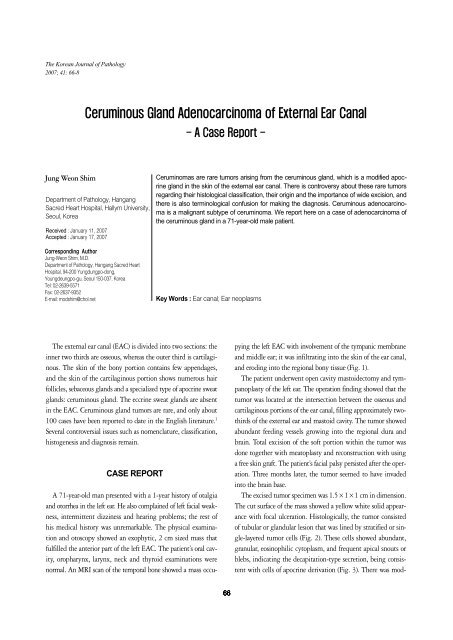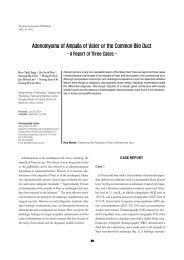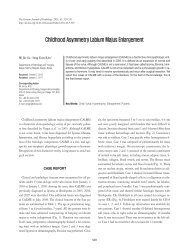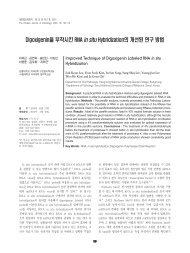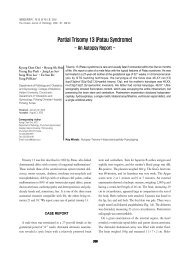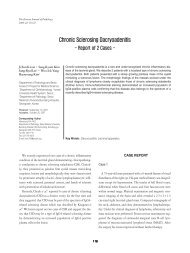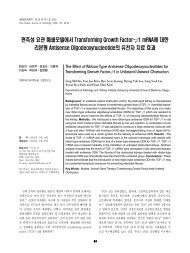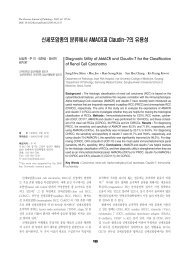Ceruminous Gland Adenocarcinoma of External Ear Canal
Ceruminous Gland Adenocarcinoma of External Ear Canal
Ceruminous Gland Adenocarcinoma of External Ear Canal
Create successful ePaper yourself
Turn your PDF publications into a flip-book with our unique Google optimized e-Paper software.
The Korean Journal <strong>of</strong> Pathology<br />
2007; 41: 66-8<br />
<strong>Ceruminous</strong> <strong>Gland</strong> <strong>Adenocarcinoma</strong> <strong>of</strong> <strong>External</strong> <strong>Ear</strong> <strong>Canal</strong><br />
- A Case Report -<br />
Jung Weon Shim<br />
Department <strong>of</strong> Pathology, Hangang<br />
Sacred Heart Hospital, Hallym University,<br />
Seoul, Korea<br />
Received : January 11, 2007<br />
Accepted : January 17, 2007<br />
Ceruminomas are rare tumors arising from the ceruminous gland, which is a modified apocrine<br />
gland in the skin <strong>of</strong> the external ear canal. There is controversy about these rare tumors<br />
regarding their histological classification, their origin and the importance <strong>of</strong> wide excision, and<br />
there is also terminological confusion for making the diagnosis. <strong>Ceruminous</strong> adenocarcinoma<br />
is a malignant subtype <strong>of</strong> ceruminoma. We report here on a case <strong>of</strong> adenocarcinoma <strong>of</strong><br />
the ceruminous gland in a 71-year-old male patient.<br />
Corresponding Author<br />
Jung-Weon Shim, M.D.<br />
Department <strong>of</strong> Pathology, Hangang Sacred Heart<br />
Hospital, 94-200 Yungdungpo-dong,<br />
Youngdeungpo-gu, Seoul 150-037, Korea<br />
Tel: 02-2639-5571<br />
Fax: 02-2637-9352<br />
E-mail: modshim@chol.net<br />
Key Words : <strong>Ear</strong> canal; <strong>Ear</strong> neoplasms<br />
The external ear canal (EAC) is divided into two sections: the<br />
inner two thirds are osseous, whereas the outer third is cartilaginous.<br />
The skin <strong>of</strong> the bony portion contains few appendages,<br />
and the skin <strong>of</strong> the cartilaginous portion shows numerous hair<br />
follicles, sebaceous glands and a specialized type <strong>of</strong> apocrine sweat<br />
glands: ceruminous gland. The eccrine sweat glands are absent<br />
in the EAC. <strong>Ceruminous</strong> gland tumors are rare, and only about<br />
100 cases have been reported to date in the English literature. 1<br />
Several controversial issues such as nomenclature, classification,<br />
histogenesis and diagnosis remain.<br />
CASE REPORT<br />
A 71-year-old man presented with a 1-year history <strong>of</strong> otalgia<br />
and otorrhea in the left ear. He also complained <strong>of</strong> left facial weakness,<br />
intermittent dizziness and hearing problems; the rest <strong>of</strong><br />
his medical history was unremarkable. The physical examination<br />
and otoscopy showed an exophytic, 2 cm sized mass that<br />
fulfilled the anterior part <strong>of</strong> the left EAC. The patient’s oral cavity,<br />
oropharynx, larynx, neck and thyroid examinations were<br />
normal. An MRI scan <strong>of</strong> the temporal bone showed a mass occupying<br />
the left EAC with involvement <strong>of</strong> the tympanic membrane<br />
and middle ear; it was infiltrating into the skin <strong>of</strong> the ear canal,<br />
and eroding into the regional bony tissue (Fig. 1).<br />
The patient underwent open cavity mastoidectomy and tympanoplasty<br />
<strong>of</strong> the left ear. The operation finding showed that the<br />
tumor was located at the intersection between the osseous and<br />
cartilaginous portions <strong>of</strong> the ear canal, filling approximately twothirds<br />
<strong>of</strong> the external ear and mastoid cavity. The tumor showed<br />
abundant feeding vessels growing into the regional dura and<br />
brain. Total excision <strong>of</strong> the s<strong>of</strong>t portion within the tumor was<br />
done together with meatoplasty and reconstruction with using<br />
a free skin graft. The patient’s facial palsy persisted after the operation.<br />
Three months later, the tumor seemed to have invaded<br />
into the brain base.<br />
The excised tumor specimen was 1.5×1×1 cm in dimension.<br />
The cut surface <strong>of</strong> the mass showed a yellow white solid appearance<br />
with focal ulceration. Histologically, the tumor consisted<br />
<strong>of</strong> tubular or glandular lesion that was lined by stratified or single-layered<br />
tumor cells (Fig. 2). These cells showed abundant,<br />
granular, eosinophilic cytoplasm, and frequent apical snouts or<br />
blebs, indicating the decapitation-type secretion, being consistent<br />
with cells <strong>of</strong> apocrine derivation (Fig. 3). There was mod-<br />
66
<strong>Ceruminous</strong> gland <strong>Adenocarcinoma</strong> <strong>of</strong> <strong>External</strong> <strong>Ear</strong> <strong>Canal</strong> 67<br />
Fig. 2. <strong>Adenocarcinoma</strong> <strong>of</strong> ceruminous gland shows proliferation<br />
<strong>of</strong> tubular or glandular lesion (H&E, ×200).<br />
Fig. 1. An MRI scan shows a mass in the left external ear canal with<br />
destruction <strong>of</strong> regional bone tissue.<br />
Fig. 4. <strong>Adenocarcinoma</strong> destroys the regional bone tissue (H&E,<br />
×200).<br />
Fig. 3. There is frequent snouting <strong>of</strong> the tumor cell cytoplasm into the<br />
lumen, being consistent with apocrine differentiation (H&E, ×400).<br />
erate nuclear pleomorphism and occasional mitoses, in keeping<br />
with adenocarcinoma. There were few myoepithelial cells, as was<br />
proved by perfoming immunohistochemistry for S-100 protein<br />
and smooth muscle actin. The surrounding tissue was desmoplastic<br />
with mixed acute and chronic inflammation. The tumor<br />
infiltrated into and destroyed the regional bone tissue (Fig. 4).<br />
DISCUSSION<br />
The term ‘‘ceruminoma’’ has long been used as a collective<br />
denomination for all ceruminous gland tumors. Such nomenclature<br />
has caused confusion regarding differentiating between a<br />
lesion’s benign and malignant nature. So, the term ‘ceruminoma’<br />
was excluded from the WHO classification in 1991, 2 but<br />
unfortunately, it is still being employed until now.<br />
Wetli et al. 3 distinguished four categories for ceruminomas:<br />
the ceruminous adenoma, the ceruminous adenoid-cystic carcinoma,<br />
the ceruminous adenocarcinoma and the pleomorphic<br />
adenoma. In 1977, Pulec 4 described two cases <strong>of</strong> a fifth entity:<br />
the mucoepidermoid carcinoma. A large cohort study on ‘ceruminoma’<br />
has not yet been done and the only reported incidence<br />
<strong>of</strong> ceruminous adenocarcinoma arising out <strong>of</strong> ceruminoma was<br />
9 out <strong>of</strong> 52 cases. 3 The criteria for making the diagnosis <strong>of</strong> malignancy<br />
may be 1) cytologically bland features with an infiltrating<br />
margin or 2) the tumor has obviously malignant cytological<br />
features, such as significant nuclear pleomorphism, or a brisk<br />
mitotic rate. 5 <strong>Ceruminous</strong> adenocarcinoma can be classified as a<br />
low or high grade adenocarcinoma depending on the degree <strong>of</strong>
68<br />
Jung Weon Shim<br />
atypia. 6 The histology <strong>of</strong> ceruminous adenocarcinoma usually<br />
shows irregular glandular structures lined by cuboidal epithelium,<br />
and this epithelium shows apocrine features such as<br />
luminal blebbing or snouting. 6 Adenoid cystic carcinoma could<br />
be differentiated from adenocarcinoma in that the former type<br />
shows cords and islands <strong>of</strong> uniform, rounded, darkly-staining<br />
cells that show pseudoglandular formation, but there is no peripheral<br />
palisading or evidence <strong>of</strong> true gland formation and there<br />
is a characteristic cribriform architecture and perineural invasion.<br />
6 It is clinically important to differentiate low-grade adenocarcinoma<br />
from a ceruminous adenoma. A sufficient tissue<br />
sample should be analyzed for the findings <strong>of</strong> stromal or bone<br />
invasion and desmoplasia in benign looking ceruminomas. Highgrade<br />
adenocarcinomas extensively infiltrate the surrounding<br />
tissues as irregular glands and sheets <strong>of</strong> overtly malignant cells.<br />
They show marked nuclear pleomorphism and abundant mitotic<br />
figures, and they may exhibit little or no evidence <strong>of</strong> apocrine<br />
derivation. 7 In this case, tubular or glandular lesion with moderate<br />
cytological atypia, and invasive growth into the regional bone<br />
tissue matched the criteria <strong>of</strong> adenocarcinoma. The tumor cells<br />
frequently showed abundant eosinophilic cytoplasm and intraluminal<br />
decapitation that fit with a ceruminous gland origin.<br />
<strong>Ceruminous</strong> adenocarcinoma exhibits a prolonged subclinical<br />
phase, <strong>of</strong>ten lasting for years before presentation, 8 as happened<br />
in our case. The clinical symptoms usually comprise a sensation<br />
<strong>of</strong> blockage in the EAC with or without hearing loss. Otoscopic<br />
examination usually demonstrates nodules covered by normal<br />
skin, with or without otorrhea, hemorrhage, lymphadenopathy<br />
or cranial nerve palsies. In contrast, ceruminous and pleomorphic<br />
adenomas present as painless nodules with or without hearing<br />
loss. Temporal bone CT scan or MRI is usually recommended<br />
to determine the extent <strong>of</strong> the lesion and the presence <strong>of</strong> osseous<br />
invasion, and to exclude extrapetrosal disease or metastasis. 5<br />
If the histopathologic analysis does not confirm a tumor’s<br />
benign nature, then the diagnosis, based on a large amount <strong>of</strong><br />
tissue, should be reanalyzed and en bloc excision with resection<br />
margins <strong>of</strong> 3 to 4 mm should be performed because the exact<br />
nature <strong>of</strong> the tumor is hardly identifiable at the time <strong>of</strong> surgery.<br />
Further, even benign and well-limited tumors, such as ceruminous<br />
adenomas have a high recurrence rate. Thompson et al. 9<br />
reported 4 out <strong>of</strong> 41 cerumious adenoma developed the recurrence<br />
due to incomplete excision. In Korea, one cerumious adenocarcinoma<br />
has been recently reported on.<br />
REFERENCES<br />
1. Soon SL, Bullock M, Prince ME. <strong>Ceruminous</strong> adenocarcinoma: a<br />
rare tumor <strong>of</strong> the external auditory canal. J Otolaryngol 2001; 30:<br />
373-7.<br />
2. Lassaletta L, Patron M, Oloriz J, Perez R, Gavilan J. Avoiding misdiagnosis<br />
in ceruminous gland tumours. Auris Nasus Larynx 2003;<br />
30: 287-90.<br />
3. Wetli CV, Pardo V, Millard M, Gerston K. Tumors <strong>of</strong> ceruminous<br />
glands. Cancer 1972; 29: 1169-78.<br />
4. Pulec JL. <strong>Gland</strong>ular tumors <strong>of</strong> the external auditory canal. Laryngoscope<br />
1977; 87: 1601-12.<br />
5. Iqbal A, Newman P. <strong>Ceruminous</strong> gland neoplasia. Br J Plast Surg<br />
1998; 51: 317-20.<br />
6. Mills RG, Douglas-Jones T, Williams RG. ‘Ceruminoma’--a defunct<br />
diagnosis. J Laryngol Otol 1995; 109: 180-8.<br />
7. Dehner LP, Chen KT. Primary tumors <strong>of</strong> the external and middle<br />
ear. Benign and malignant glandular neoplasms. Arch Otolaryngol<br />
1980; 106: 13-9.<br />
8. Garin P, Degols JC, Delos M, Marbaix E. Benign ceruminous tumours<br />
<strong>of</strong> the external ear canal. J Otolaryngol 1999; 28: 99-101.<br />
9. Thompson LD, Nelson BL, Barnes EL. <strong>Ceruminous</strong> adenomas: a<br />
clinicopathologic study <strong>of</strong> 41 cases with a review <strong>of</strong> the literature.<br />
Am J Surg Pathol 2004; 28: 308-18.<br />
10. Kwon YH, Choi JH, Kim HJ, Jung HH. A Case <strong>of</strong> <strong>Ceruminous</strong> <strong>Adenocarcinoma</strong><br />
arising from the external auditory canal. Korean J<br />
Otolaryngol-Head Neck Surg 2004; 47: 1311-4.


